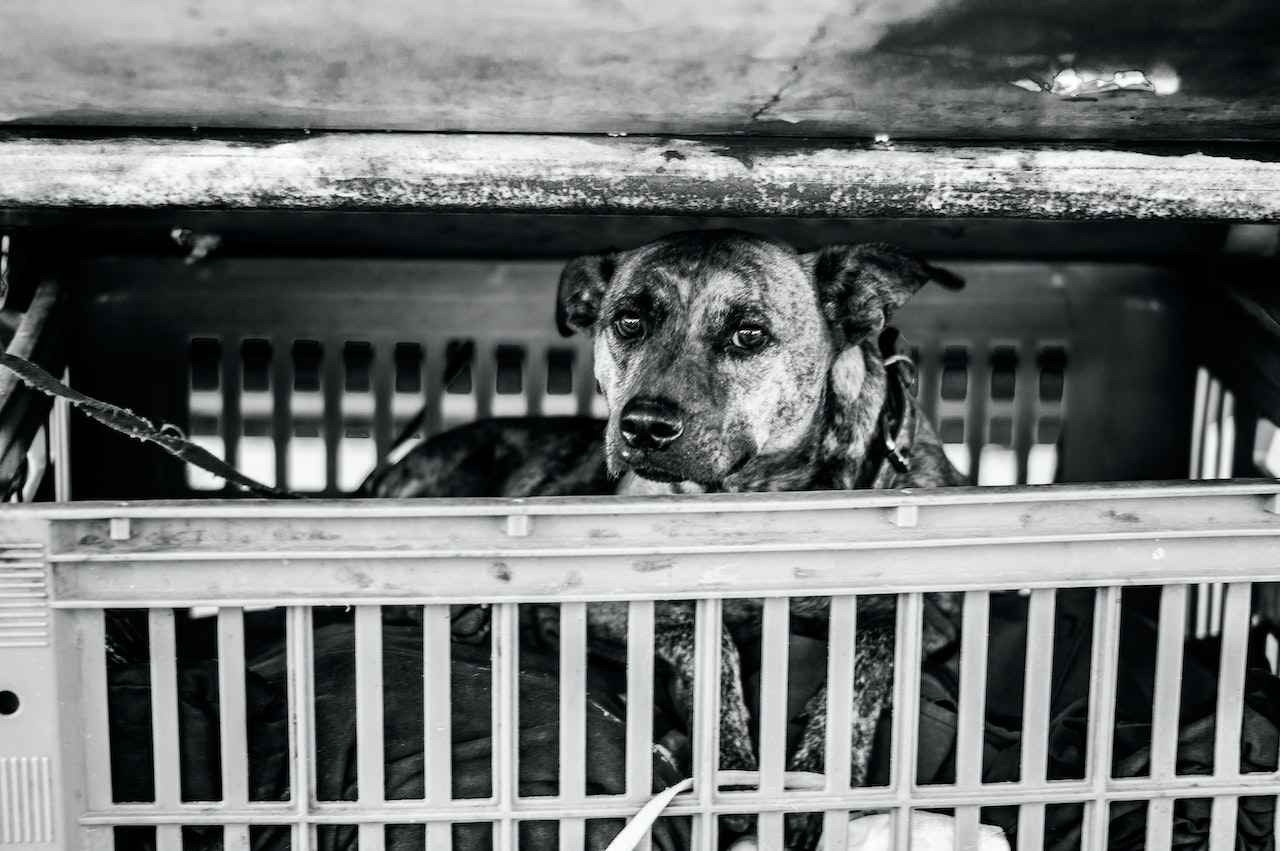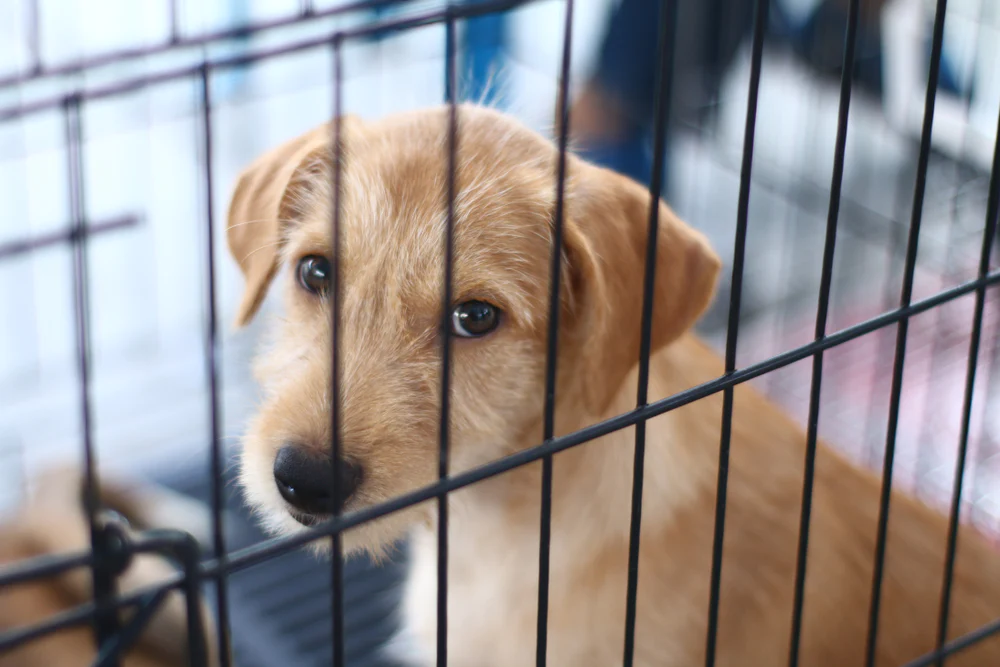You’re just starting to bond with your puppy. He’s crying in the crate. Here are some suggestions.

Crate your puppy overnight for a variety of reasons. Safety is the most important. If your home is not puppy-proofed, puppies can get into serious trouble. The crate is also helpful for house training. The crate is safe for puppies and prevents them from slipping out of it. Crates protect household items from sharp puppy teeth. Crate training is also useful in an emergency situation and if your dog has to be admitted to the vet. The first few nights can be difficult. This is what you should do if your puppy starts to cry in the crate at night.
Place the Crate
Your bedroom is the best place to keep your crate overnight. It is easier to tell your dog if he needs to go potty. Your presence is comforting. Puppies aren’t used to being left alone when they have been separated from their mother and littermates.
Suzanne Bryner, Lucky Fido Dog Training in Friday Harbor WA says that puppies are children and need to feel secure. She suggests placing the crate beside the bed. If they do wake up, you can place the crate next to their bed. If they have just gone or had access to toilet paper, “it will be simple for you to reach down to let them snuffle your hands, talk softly, sweetly, and give them some tickle.” It is possible to comfort them without getting them out of the crate.
You can move the crate from one place to another if the bedroom is not where your dog wants it to be. During the day, move the crate to another location in your home. Continue crate training sessions with treats and dinner.
First Night

It’s not unusual for your puppy to experience some difficulties when they first move into your home. You may not have completed crate training with your puppy (see the sidebar to learn how to teach your dog to love the cage), so they won’t be ready to spend the night in the crate. They may cry for company, reassurance, or a break from the bathroom.
Kathrine Christ, of Hands Full Dog training in Wichita Kansas, says that “The first night with your puppy might be the most difficult.” Don’t give up; your puppy will establish a routine in the following days, and everything will settle down.
If your dog cries, you can take him outside to use the bathroom. To prevent any accidents, carry him along. You can also leave your shoes, coat, and treats (to reward toileting), in a convenient place. Put your puppy back into the crate. Kathrine states, “Our goal is for puppies to feel relaxed in their crate. If he doesn’t settle in a few minutes, he should go out of the crate immediately and be reintroduced in a manner that doesn’t cause any unpleasant feelings.” It is better to take him out now than to make him hate the crate.
“If your dog cries at night in his crate, it’s a sign that your instinct is to help him. “
You may find it helpful to keep your puppy in a puppy pen while you train him. If your puppy isn’t yet old enough to hold it overnight, which is usually not until seven to eight months, and you don’t have the time or ability to take him outside to use the toilet, a large crate/puppet pen with ample space for a potty pad can be used. This may cause your dog to go outside only if you are trying to housetrain him.
Young puppies, aged six weeks and less, need to go to the bathroom every half an hour. However, after that, a guideline is that they can “hold it” for at least as long as their age in months. A puppy 12 weeks old should be able to wait for three hours, but it may take longer. To house-train your puppy, go outside every one to two hours to the toilet and reward him for doing so. You don’t have to disturb your puppy if he’s asleep. Kathrine says that some books recommend taking your puppy out every one-to-two hours, but with this caveat. Some puppies can go to sleep for hours straight away.
Puppy Cries

Your instinct will be to help your dog if he cries in his crate at night. Even though it is possible for people to worry that he might start crying if he gets out of his crate, this shouldn’t be a problem. You want him to know that you are there for him when he is crying. You might need to take him outside for a pee break or just to provide some comfort.
“Puppies learn from their consequences. A puppy might learn that communicating with you means they are free from their crate. Guess what? It’s not a bad thing! says Kathrine. Kathrine: “If one of my dogs has to go potty (or throw up), I will let them out!” If they’re afraid of thunder or need to potty, they’ll whine in the cage. They know that I’ll let them out. She suggests that you use a gradual crate training program to build positive associations with your dog.
Suzanne agrees. Suzanne agrees. It is important to emphasize that puppies are best loved when we show kindness and comfort. It is never wrong to comfort your puppy.
A puppy’s ability to hold their bladder for more than an hour after eight weeks is normal. The rule of thumb is that puppies can hold their bladder for one hour per month. If your puppy is 2 months old, it can hold their bladder for approximately 2 hours. You will need to either get up with your puppy at night, or you can set up a bigger kennel/xpen that has enough space for a puppy pad.
Don’t Rush Crate Training
Many people expect their dog to be in the crate all day without training. This can lead to stress and make them dislike or even hate the crate. If your pup suffers from separation anxiety, this can lead to problems later. Meghan D’Arcy of Meghan D’Arcy training and behavior in Toronto, ON is a Certified Separation anxiety Trainer. She says that separation anxiety can sometimes mean people need to give up using a crate. She says that separation anxiety can be caused by a puppy’s strong dislike of the crate. Dogs suffering from separation anxiety are often unable to handle being crated. Guardians have reported that their dogs have tried to escape the crate by breaking crate bars, cracking their teeth, or causing their paws and paws to bleed. This is rare but it’s worth taking the time to properly introduce the crate.
Is Crating Essential?

You have the option of sleeping with your dog overnight. Some puppies that don’t sleep well in their crate at night will be happy to cuddle with you at night. If you are desperate, or just want to cuddle your dog, you can do this if you so choose. says, Kathrine. Kathrine has some words of wisdom: “You may want to cover your bed with a waterproof covering, but you don’t need to use your Anthropologie duvet. But there are no dangers in letting your dog sleep in your bed.”
Every accident can be a setback in toilet training. This is why most people wait until their puppy is house-trained before letting them sleep on the bed. Remember that some puppies might not like to sleep in the bed, especially when they grow larger.
Teach Puppy How to Love the Crate
Crate-loving puppies aren’t something they were born to love. You have to show them how to love them. To help your puppy see their crate in a positive light, use lots of treats and reinforcement.
Lucky Fido Dog Training, Friday Harbor, WA: Suzanne Bryner says, “We want puppies feel really happy about their crate. It’s not enough to be happy with it. So we recommend that you take your puppy through each step of crate training and make sure they are happy at each step.”
Make sure that the crate has been set up correctly. The crate should be large enough for them to stand up, stretch and turn around. To make sure your crate is large enough to allow for growth, you can use the divider. Add some comfortable bedding.
Play with your dog and then put them in the crate when they are tired. They should be able to sleep happily. You can let your puppy go outside immediately after they get up.
Meghan D’Arcy of Meghan D’Arcy training and behavior in Toronto, Ontario says, “Make your puppy’s crate comfy with both a blanket and a bed. Because puppies love to burrow and need warmth, and they will soon be able to sleep in it.”

Begin by allowing your puppy to use the crate whenever they want. Be generous and give the puppy nice treats, but keep them small. Meghan suggests, “Start by tossing some treats right inside the door. Then move on to tossing more and more back. Sprinkle treats around the cage throughout the day for your dog to find.
To help foster positive associations, you should also follow a crate training program. To make the meal last longer, you can use a rubber chewy toy or a rubber bowl to feed it. Meghan advises, “Initially, be there while your puppy eats and then get your puppy out of their crate when they are done. Remember that most puppies want to go potty after eating. Comfort can be increased by dropping a treat every 10-15 seconds in the crate and allowing your puppy to move around the room or step away briefly.
Remember that puppies and dogs of any age shouldn’t be kept in a crate for too long. Crates are a place of refuge, rest, and for puppies, a training aid. You should not confine your dog to this area.
Summary
They may cry at night if they aren’t getting their needs met. Find out what they are looking for and then go from there. Remember that the first few nights can be difficult, but it will get easier as you go on.